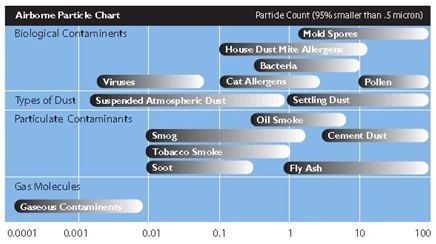The Importance of Indoor Air Quality
Allergies, illness, and long-term health can be impacted by the quality of the air inside our homes. According to the Environmental Protection Agency, the air inside our home can be two to ten times worse than outside air. This is not surprising since for the last forty years consumers have been working to improve energy efficiency in their homes. The rapid rise in the occurrence of allergies and other breathing disorders caused by the increased level of contaminants in indoor air means the problem is real and only getting worse. It can often be difficult for our immune systems to keep up with the abundance of particles, germs, and gases that are locked inside our tight, energy-efficient homes.
Is Your Home Making You Sick?
There are many sources of indoor air pollution in a home. These can include combustion sources such as oil, gas, kerosene, or wood, tobacco products, building materials and furnishings, asbestos-containing insulation, wet or damp carpet, cabinetry or furniture made of certain pressed wood products, products for household cleaning and personal care, and outdoor sources such as radon, pesticides, and outdoor air pollution.
 So imagine breathing those in. Our bodies act like filters. We will generally catch the larger contaminants, yet the smallest of these – and the ones that are potentially the most injurious to our health, pass into our lungs and often into our bloodstreams.
So imagine breathing those in. Our bodies act like filters. We will generally catch the larger contaminants, yet the smallest of these – and the ones that are potentially the most injurious to our health, pass into our lungs and often into our bloodstreams.
Particles: Have you ever seen the sun’s rays streaming through a window and you can see all of the dust floating around in the sunbeam? There are millions of microscopic particles that float around in the air all the time. And those in the sunbeam are only the ones that are actually big enough to see. Ninety eight percent of all airborne particles measure below 1 micron (1/25,000 inch) in size and are invisible to the naked eye.
Studies show that breathing particles that measure below three microns in size can be detrimental to our health and 98% of all particles we breathe are less than one micron in size. That's some small stuff that disposable filters are not capable of removing from the air.
Biological Contaminants: Biological contaminants include germs and infectious agents, viruses, bacteria, molds and pollen. Biologicals can also create offensive odors. High output UVC lamps can disrupt the DNA of these biologicals rendering them harmless and incapable of reproducing which prevents their growth inside your HVAC system, duct work and the air you breathe.
Gas Phase Contaminants: Gaseous contaminants include chemicals and odors that come from household materials like cleaners and pesticides. Building materials can off-gas dangerous chemicals such as formaldehyde. With today’s tight building construction, the air inside our homes becomes “stale” and this “toxic soup” of chemicals is continually re-circulated through our homes. Dual wavelength UV lamps can oxidize and breakdown these gas phase contaminants. Activated carbon matrix systems can also adsorb these odors and gases removing them from the air you breathe.
What Can You Do?
The best air quality solutions address the causes rather than the symptoms, using a whole house indoor air cleaning strategy. A typical heating and cooling system moves over a million cubic feet of air throughout our home every day. This is the perfect place to address air quality challenges using products designed specifically to address the three types of indoor airborne contaminants. A whole house air cleaning system that cleans, disinfects, and deodorizes our home 24 hours a day is much more effective than units designed for just a room or two.